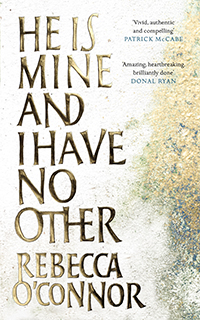He is Mine
 He Is Mine and I Have No Other
He Is Mine and I Have No Other
Rebecca O’Connor
ISBN: 9781786892591
$25
230 pp
Canongate 2018
A teenage girl (fifteen years old) in rural Ireland at the close of the twentieth century, Lani struggles to make sense of the people and the world around her and how it all relates to her. Fairly standard fare for a novel about – and for – young adults.
Rebecca O’Connor has crafted a fine work with rounded, believable characters. Lani tells her story in her own words and describes vicissitudes of dealing with parents, girls at school, rules, expectations and the boy she decides is hers, even before she has properly met him.
“He used to walk by our house every day at the same time, up past Molly’s house to the cemetery.”
She doesn’t know his name or where he lives. She assumes he attends the boy’s school; she attends the girls’ school. She could approach him in the cemetery any day but she doesn’t.
Woven throughout the novel is a totally separate story, involving thirty-five ‘orphaned’ girls who perished in a fire and whose stories are told in a book written by Lani’s aunt. These stories expose chilling abuse by the nuns in the ‘industrial school’ where these orphaned and abandoned girls lived, along with the heart-rending accounts of how they came to be there.
The relationship between Lani’s Aunt Celia and the rest of the family is eventually revealed and is tragic in a way so many families experience the consequences of strict religion and societal embargos, lies, miscommunications, misunderstandings and malice.
Rebecca O’Connor is an artist in the way she paints the lives of the teens: with depth, compassion, understanding and humour. Lani has no map to help her navigate the world in which she lives: her family, school, other girls, neighbours, the cemetery and abandoned buildings, and, eventually, Leon, the boy who walks past her house every day. She has no real help in dealing with love or lust, although she is clear about what is involved in sex and reproduction.
Although this is pre-mobile phone Ireland, the issues that teenagers were forced to deal with are not that different from the issues Australian teens have to deal with. The availability of instant communication and the frequent nastiness of social media posts probably exacerbate the issues. From films and books coming out of the USA I gather it is no easier there.
Lani’s family is not particularly dysfunctional, although she sometimes considers it so. The family dynamics are finely observed by the author, who creates them such that they could be yours or mine. This is part of the magic ‘ordinariness’ of the characters and their experiences – there is nothing jarring about them, nothing unbelievable. This is the author’s genius, that she opens a window into ordinary lives and draws us in to marvel at how they manage to live their lives as we all might and have it fascinate us. We all know people like these and we probably are ourselves like some of them – or we may have been in the past.
Writers often use the artifice of revealing things as a novel progresses, in order to keep the reader in the dark in a controlled way – or they keep the characters in the dark about things revealed to the reader. There is nothing like that here – the characters themselves are ignorant of things about other characters in the way that happens in real life and the reader is no better informed than the characters are. The only advantage adult readers may have over the teen characters is experience, and we (adults) can look on in bemusement as they fumble and learn.
There is tragedy in this novel, but the characters grow and develop, and they survive. The reader also lives through these tragedies and comes out of it all changed. This the mark of a novel worth reading.
[to receive an email each time a new review is posted, email me: <daan [dot] spijer [at] gmail [dot] com>]
 CLICK HERE to download a formatted PDF of the above post
CLICK HERE to download a formatted PDF of the above post
 See more of Daan Spijer’s writing and his photos at Seventh House Communications and at Medium.com
See more of Daan Spijer’s writing and his photos at Seventh House Communications and at Medium.com